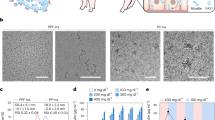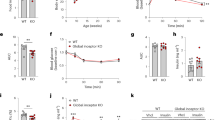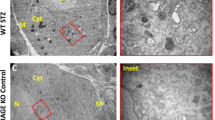Abstract
Aim:
To test whether the neurogenic differentiation (NeuroD) protein could alleviate symptoms of diabetes mellitus by its transduction activity in vivo.
Methods:
Type 1 diabetes mellitus in mice was induced by ip (intraperitoneal) injection of streptozotocin (150 mg/kg). One group of diabetic mice were intravenously injected with the NeuroD-EGFP (Enhanced Green Fluorescent Protein) (5 mg/kg, n = 6) and the other group with EGFP (5 mg/kg, n = 5). After the transduction of NeuroD-EGFP, the distribution of the protein was examined by means of frozen section under fluorescent microscope observation. We conducted RT-PCR and Real-time quantitative PCR to measure the transcription levels of insulin mRNA. Immunohistochemistry was utilized to detect the insulin protein. Radioimmunoassay was conducted to determine the serum insulin levels. Blood glucose levels and body weights were regularly recorded after the protein administration.
Results:
The NeuroD protein can be transduced into cells in vivo with a high efficiency of nearly 100%. Insulin mRNA was highly expressed in NeuroD-treated diabetic mice, 38-fold higher than that of control group (P<0.05). Immunohistochemistry revealed enteric insulin expression in the NeuroD-treated diabetic mice. The fasting serum insulin level of the NeuroD-EGFP group (n=6) was 337±39 pg/mL, significantly higher than that of the control diabetic mice (n=5) which was 84±23 pg/mL (P<0.01, t-test). Records of blood glucose level also displayed alleviation of hyperglycemia after NeuroD administration (P<0.01, t-test, n=6).
Conclusion:
In vivo-transduced NeuroD in the small intestine remained functionally active and could ameliorate the non-fasting glucose levels of streptozotocin-induced, diabetic mice by inducing enteric insulin expression.
Similar content being viewed by others
Log in or create a free account to read this content
Gain free access to this article, as well as selected content from this journal and more on nature.com
or
References
Green M, Loewenstein PM . Autonomous functional domains of chemically synthesized human immunodeficiency virus tat trans-activator protein. Cell 1988; 55: 1179–88.
Frankel AD, Pabo CO . Cellular uptake of the tat protein from human immunodeficiency virus. Cell 1988; 55: 1189–93.
Noguchi H, Matsumoto S . Protein transduction technology offers a novel therapeutic approach for diabetes. J Hepatobiliary Pancreat Surg 2006; 13: 306–13.
Snyder EL, Dowdy SF . Recent advances in the use of protein transduction domains for the delivery of peptides, proteins and nucleic acids in vivo. Expert Opin Drug Deliv 2005; 2: 43–51.
Harbour JW, Worley L, Ma D, Cohen M . Transducible peptide therapy for uveal melanoma and retinoblastoma. Arch Ophthalmol 2002; 120: 1341–6.
Arnt CR, Chiorean MV, Heldebrant MP, Gores GJ, Kaufmann SH . Synthetic Smac/DIABLO peptides enhance the effects of chemotherapeutic agents by binding XIAP and cIAP1 in situ. J Biol Chem 2002; 277: 44236–43.
Vucic D, Deshayes K, Ackerly H, Pisabarro MT, Kadkhodayan S, Fairbrother WJ, et al. SMAC negatively regulates the anti-apoptotic activity of melanoma inhibitor of apoptosis (ML-IAP). J Biol Chem 2002; 277: 12275–9.
Mai JC, Mi Z, Kim SH, Ng B, Robbins PD . A proapoptotic peptide for the treatment of solid tumors. Cancer Res 2001; 61: 7709–12.
Hosotani R, Miyamoto Y, Fujimoto K, Doi R, Otaka A, Fujii N, et al. Trojan p16 peptide suppresses pancreatic cancer growth and prolongs survival in mice. Clin Cancer Res 2002; 8: 1271–6.
Aarts M, Liu Y, Liu L, Besshoh S, Arundine M, Gurd JW, et al. Treatment of ischemic brain damage by perturbing NMDA receptor-PSD-95 protein interactions. Science 2002; 298: 846–50.
Cao G, Pei W, Ge H, Liang Q, Luo Y, Sharp FR, et al. In vivo delivery of a Bcl-xL fusion protein containing the TAT protein transduction domain protects against ischemic brain Injury and neuronal apoptosis. J Neurosci 2002; 22: 5423–31.
Bucci M, Gratton JP, Rudic RD, Acevedo L, Roviezzo F, Cirino G, et al. In vivo delivery of the caveolin-1 scaffolding domain inhibits nitric oxide synthesis and reduces inflammation. Nat Med 2000; 6: 1362–7.
Schranz DB, Lernmark A . Immunology in diabetes: an update. Diabetes Metab Rev 1998; 14: 3–29.
Adorini L, Gregori S, Harrison LC . Understanding autoimmune diabetes: insights from mouse models. Trends Mol Med 2002; 8: 31–8.
Notkins AL . Immunologic and genetic factors in type 1 diabetes. J Biol Chem 2002; 277: 43545–8.
Jun HS, Yoon JW . Approaches for the cure of type 1 diabetes by cellular and gene therapy. Curr Gene Ther 2005; 5: 249–62.
Weir GC, Bonner-Weir S . Scientific and political impediments to successful islet transplantation. Diabetes 1997; 46: 1247–56.
Wilson ME, Scheel D, German MS . Gene expression cascades in pancreatic development. Mech Dev 2003; 120: 65–80.
Suzuki A, Nakauchi H, Taniguchi H . Glucagon-like peptide 1(1–37) converts intestinal epithelial cells into insulin-producing cells. Proc Natl Acad Sci USA 2003; 100: 5034–9.
Koizumi M, Nagai K, Kida A, Kami K, Ito D, Fujimoto K, et al. Forced expression of PDX-1 induces insulin production in intestinal epithelia. Surgery 2006; 140: 273–80.
Yoshida S, Kajimoto Y, Yasuda T, Watada H, Fujitani Y, Kosaka H, et al. PDX-1 induces differentiation of intestinal epithelioid IEC-6 into insulin-producing cells. Diabetes 2002; 51: 2505–13.
Kojima H, Nakamura T, Fujita Y, Kishi A, Fujimiya M, Yamada S, et al. Combined expression of pancreatic duodenal homeobox 1 and islet factor 1 induces immature enterocytes to produce insulin. Diabetes 2002; 51: 1398–408.
Naya FJ, Huang HP, Qiu Y, Mutoh H, DeMayo FJ, Leiter AB, et al. Diabetes, defective pancreatic morphogenesis, and abnormal enteroendocrine differentiation in BETA2/neuroD-deficient mice. Genes Dev 1997; 11: 2323–34.
Kaneto H, Nakatani Y, Miyatsuka T, Matsuoka TA, Matsuhisa M, Hori M, et al. PDX-1/VP16 fusion protein, together with NeuroD or Ngn3, markedly induces insulin gene transcription and ameliorates glucose tolerance. Diabetes 2005; 54: 1009–22.
Kojima H, Fujimiya M, Matsumura K, Younan P, Imaeda H, Maeda M, et al. NeuroD-betacellulin gene therapy induces islet neogenesis in the liver and reverses diabetes in mice. Nat Med 2003; 9: 596–603.
Chen J, Li G, Lu J, Chen L, Huang Y, Wu H, et al. A novel type of PTD, common helix-loop-helix motif, could efficiently mediate protein transduction into mammalian cells. Biochem Biophys Res Commun 2006; 347: 931–40.
Noguchi H, Bonner-Weir S, Wei FY, Matsushita M, Matsumoto S . BETA2/NeuroD protein can be transduced into cells due to an arginine- and lysine-rich sequence. Diabetes 2005; 54: 2859–66.
Ferber S, Halkin A, Cohen H, Ber I, Einav Y, Goldberg I, et al. Pancreatic and duodenal homeobox gene 1 induces expression of insulin genes in liver and ameliorates streptozotocin-induced hyperglycemia. Nat Med 2000; 6: 568–72.
Ber I, Shternhall K, Perl S, Ohanuna Z, Goldberg I, Barshack I, et al. Functional, persistent, and extended liver to pancreas transdifferentiation. J Biol Chem 2003; 278: 31950–7.
Wang AY, Ehrhardt A, Xu H, Kay MA . Adenovirus transduction is required for the correction of diabetes using Pdx-1 or neurogenin-3 in the liver. Mol Ther 2007; 15: 255–63.
Potten CS, Booth C, Pritchard DM . The intestinal epithelial stem cell: the mucosal governor. Int J Exp Pathol 1997; 78: 219–43.
Miyachi T, Maruyama H, Kitamura T, Nakamura S, Kawakami H . Structure and regulation of the human NeuroD (BETA2/BHF1) gene. Brain Res Mol Brain Res 1999; 69: 223–31.
Noguchi H, Matsumoto S . Protein transduction technology: a novel therapeutic perspective. Acta Med Okayama 2006; 60: 1–11.
Kaur P, Potten CS . Circadian variation in migration velocity in small intestinal epithelium. Cell Tissue Kinet 1986; 19: 591–9.
Author information
Authors and Affiliations
Corresponding author
Rights and permissions
About this article
Cite this article
Huang, Y., Chen, J., Li, G. et al. Reversal of hyperglycemia by protein transduction of NeuroD in vivo. Acta Pharmacol Sin 28, 1181–1188 (2007). https://doi.org/10.1111/j.1745-7254.2007.00626.x
Received:
Accepted:
Issue date:
DOI: https://doi.org/10.1111/j.1745-7254.2007.00626.x



